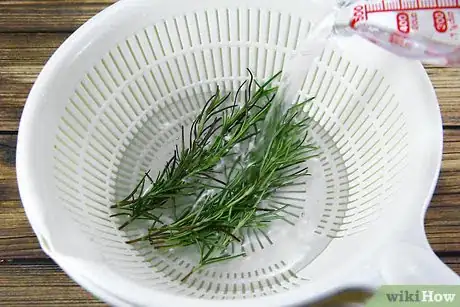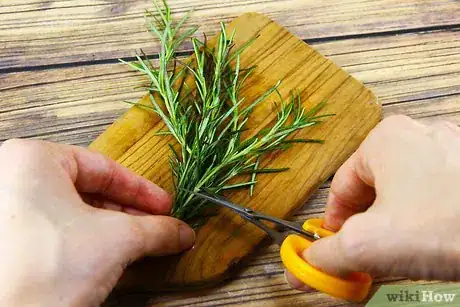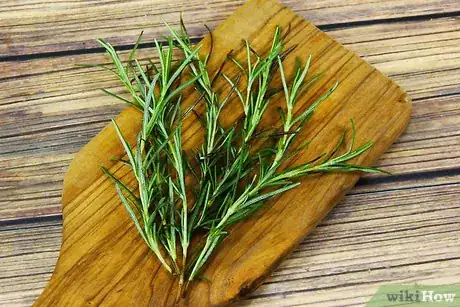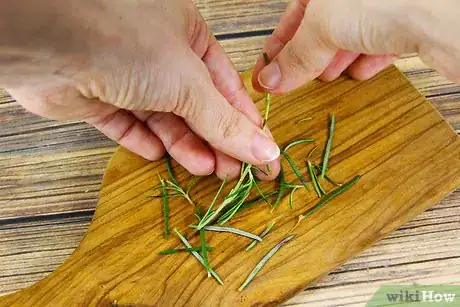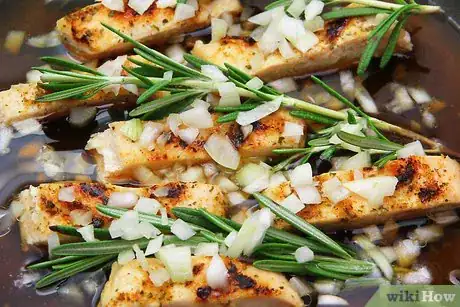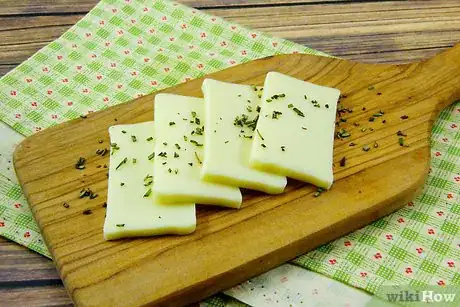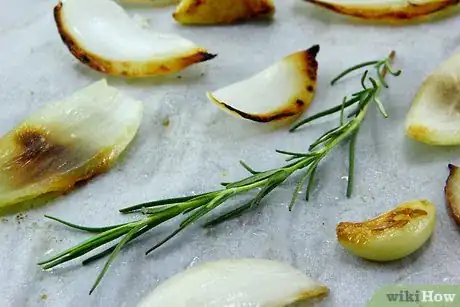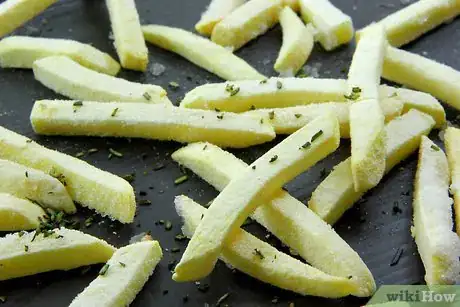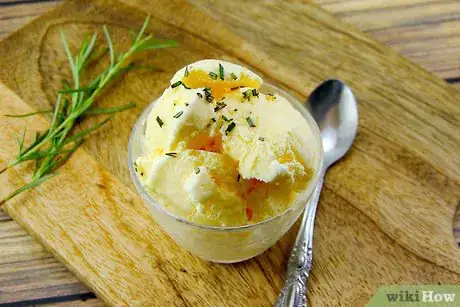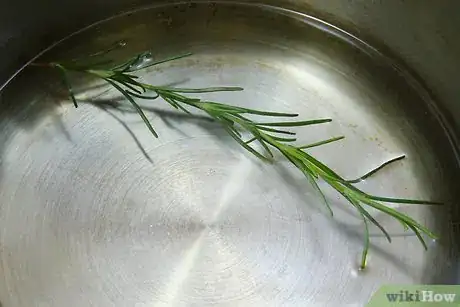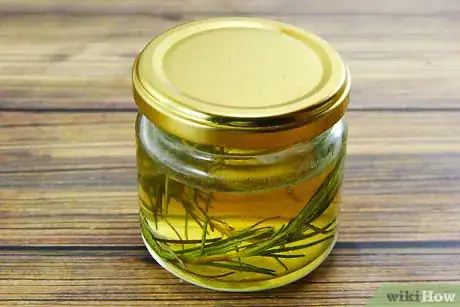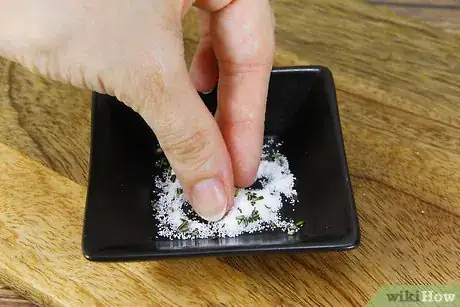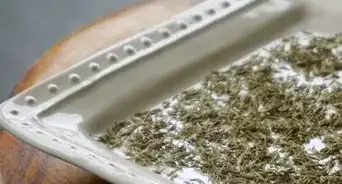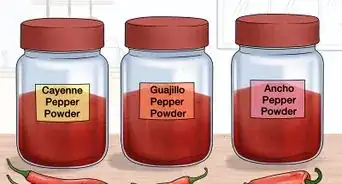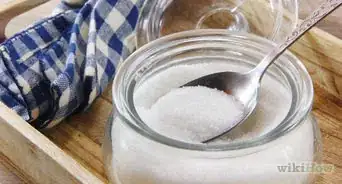This article was co-authored by Ollie George Cigliano. Ollie George Cigliano is a Private Chef, Food Educator, and Owner of Ollie George Cooks, based in Long Beach, California. With over 20 years of experience, she specializes in utilizing fresh, fun ingredients and mixing traditional and innovative cooking techniques. Ollie George holds a BA in Comparative Literature from The University of California, Berkeley, and a Nutrition and Healthy Living Certificate from eCornell University.
There are 13 references cited in this article, which can be found at the bottom of the page.
wikiHow marks an article as reader-approved once it receives enough positive feedback. This article received 14 testimonials and 80% of readers who voted found it helpful, earning it our reader-approved status.
This article has been viewed 421,133 times.
Rosemary is a popular herb that originated in the Mediterranean, and that’s often used in Italian and French cuisine. The herb is spicy and warm, and is often paired with rich meats like lamb, with sour lemons, and even with sweet dishes. The key to using rosemary in cooking is to chop it finely, because the needles can be quite tough otherwise. Rosemary is a favorite in savory cooked dishes, baked goods, and even added to desserts.
Steps
Washing and Chopping Rosemary for Cooking
-
1Rinse the rosemary. Place the rosemary bunch in a colander and pour running water over it. You can also rub the sprigs with your hands under the water to help loosen any dirt or other leftover debris from the garden. Transfer the washed rosemary to a tea towel and pat it dry. According to Chef Ollie George Cigliano, "Fresh rosemary can be kept for a couple of days in the refrigerator or easily dried by hanging w kitchen twine or a food safe rubber band."[1]
-
2Trim off individual sprigs. Use a pair of sharp scissors or a knife to cut single sprigs of rosemary from the bunch. Remove the sprigs at the bottom where they grow out from the larger bunch. You can also trim off and discard any large pieces of stem that have no needles.
- Rosemary stems are flavorful, but they're woody, tough, and not pleasant to eat.
Advertisement -
3Leave the sprigs intact for garnish and flavoring. Full sprigs of rosemary are great for finishing, garnishing, and adding flavor to certain dishes. You can either add the sprigs after cooking to finish a dish, or you can cook roasts, soups, and other meals with full sprigs of rosemary.
- Like bay leaves, rosemary sprigs that are cooked with foods are typically removed before serving.
-
4Strip off the needles. Pinch the tip of the rosemary sprig and use your other hand to wrap your fingers around the stem just below the tip. Apply gentle pressure and slide your fingers down the stem to strip off the needles. Transfer the needles to a cutting board and discard the stems.[2]
- Instead of discarding the stems, you can also hang it up to dry and store it to use as a skewer for vegetables and meat that you want to barbecue.
- When you want to include rosemary right in your recipes, it’s best to use the individual needles rather than the full sprig.
-
5Dice the needles. With a sharp knife, chop the rosemary needles until they're very fine. Rosemary needles can be quite tough, even when cooked, and this will help to make them easier to eat.[3]
Adding Rosemary to Cooking and Baking
-
1Make herbed breads and baked goods. Fresh and diced rosemary is a popular herb to add flavor and spice to savory baked goods and bread products. Chef Ollie George Cigliano notes that you will have best results with rosemary if you "add [it] early in [the] cooking process."[4] Some of the most common rosemary pairings include:[5]
- Fresh rosemary bread, and focaccia in particular
- Homemade rosemary crackers
- Rosemary and herb scones
- Fresh rosemary pasta or gnocchi
-
2Cook it with fish and meats. According to Chef Ollie George Cigliano, rosemary pairs well with "Poultry, lamb, [...] chicken, eggs, [...] fish, [...] pork, soups, [and] stews."[6] You can stuff meat with whole sprigs of rosemary, roast meat with sprigs, or use diced rosemary to add flavor. To make an all-purpose rub for any grilled, sautéed, stir fried, roasted, or broiled meat, combine:[7]
- 1 tablespoon (7 g) ground black pepper
- 1 tablespoon (19 g) salt
- 3 tablespoons (9 g) chopped fresh rosemary
- 1 tablespoon (3 g) dried rosemary
- 8 cloves garlic, diced
-
3Add it to cheesy dishes. Cheese and rosemary go together like peas in a pod, and there are many ways that you can spice up cheese-based meals with this herb. Add rosemary to a variety of dishes by sprinkling the finished product with 1 to 3 teaspoons (1 to 3 g) of the freshly diced herb. Good pairings include:
- Macaroni and cheese
- Homemade baked cheese sticks
- Pizza[8]
- Mozzarella sticks
- Cheese sandwiches
- Cheese fondue
-
4Roast vegetables with it. Chef Ollie George Cigliano lists the following fruits and vegetables as complimentary with rosemary: "roasted potatoes, roasted root vegetables, summer and winter squashes, apricots, beans, bell peppers, cabbage, [...] eggplant, [...] lentils, peas, [and] tomatoes."[9] Roasted vegetables are another excellent way to use whole sprigs of rosemary to flavor a dish. Toss together in a roasting pan chopped potatoes, carrots, parsnips, and other vegetables with a drizzle of oil, a squeeze of fresh lemon juice, and one or two sprigs of fresh rosemary. Roast the vegetables for 35 to 40 minutes in a 400 F (204 C) oven until tender and golden.[10]
- Other good roasting vegetables include sweet potatoes, celery root, zucchini, peppers, asparagus, and eggplant.
-
5Take your potato wedges to the next level. Arguably one of the most common food and herb pairings is potatoes and rosemary. You can add rosemary to any type of potato, including with roasted potatoes, in mashed potatoes, or even sprinkled on scalloped potatoes. To make rosemary fries or wedges:[11]
- Wash and scrub three russet potatoes
- Cut the potatoes into wedges or fries
- Season the potatoes with 2 tablespoons (30 ml) of oil and salt and pepper
- Bake the wedges in a 475 F (246 C) oven for 30 to 35 minutes, flipping twice during the cooking time
- Season with diced rosemary, minced garlic, and additional salt and pepper
-
6Whip up a rosemary and lemon sorbet. Sorbet is a frozen dessert made from fruit juice and sugar, and when you make your own homemade sorbet, you can use any juice you like and add any extra flavors you want. Lemon sorbet is an ideal dessert to add rosemary to, because lemon and rosemary are paired together so often in other dishes.[12]
- To make your lemon sorbet a lemon-rosemary sorbet, add 1 teaspoon (1 g) of diced rosemary to the saucepan when you make the simple syrup.
Finding Other Uses for Rosemary
-
1Make tea. Rosemary tea is a warming and delicious tea that you can make with just two simple ingredients, which are water and rosemary. Boil some water in a kettle or in a saucepan on the stove. Place a sprig of fresh rosemary into a teapot and fill the pot with boiling water. Let the tea steep for three to five minutes.[13]
- You can also add a wedge of lemon to the tea as well.
- You can also transfer room-temperature rosemary tea to an airtight container and chill it in the refrigerator to drink cold. Remove the rosemary before storing, and drink the tea within a few days of brewing.
-
2Infuse oil. To infuse oil with rosemary aromatics, combine ½ (118 ml) of olive oil in a saucepan with three sprigs of fresh rosemary. Heat the oil over low heat for about five minutes, until it reaches 180 F (82 C). Remove the oil from the heat and let it cool to room temperature. Transfer the cooled oil and rosemary to an airtight container and store it in the refrigerator for up to a month.[14]
- You can use the rosemary oil in place of regular oil for cooking, frying, and making salad dressings.
-
3Make a rosemary butter. Herbed butters are delightful ways to enjoy fresh herbs and spices, and you can make your own rosemary butter for a variety of uses. Some of the best ways to use rosemary butter include:[15]
- Spreading it on toast
- As a sauce for grilled fish or meat
- On baked or roasted potatoes
- Melted in with hot rice, pasta, or vegetables
-
4Make rosemary salt. Rosemary salt is great for adding extra flavor to any dish. To make the rosemary salt, combine ¼ cup (75 g) of coarse salt and 1 teaspoon (1 g) of dried rosemary in a food processor. Pulse the mixture to fully combine the salt and rosemary. Transfer the mixture to an airtight container and let it rest for a day.[16]
- Use the rosemary salt in place of regular salt to season any foods, such as soups, stews, salads, meats, vegetables, popcorn, and more.
- For best results, use the salt within a year.
- You can also add lemon, lime, or orange zest to the salt as well.
-
5Flavor your lemonade. Because lemon and rosemary go so well together, it may come as no surprise that you can even add rosemary to your lemonade or favorite lemon cocktails.[17] After making your lemonade, add two to three sprigs of fresh rosemary to the pitcher and let the rosemary infuse into the lemonade for a few hours before serving.
Expert Q&A
-
QuestionWhat foods taste good with rosemary?
 Ollie George CiglianoOllie George Cigliano is a Private Chef, Food Educator, and Owner of Ollie George Cooks, based in Long Beach, California. With over 20 years of experience, she specializes in utilizing fresh, fun ingredients and mixing traditional and innovative cooking techniques. Ollie George holds a BA in Comparative Literature from The University of California, Berkeley, and a Nutrition and Healthy Living Certificate from eCornell University.
Ollie George CiglianoOllie George Cigliano is a Private Chef, Food Educator, and Owner of Ollie George Cooks, based in Long Beach, California. With over 20 years of experience, she specializes in utilizing fresh, fun ingredients and mixing traditional and innovative cooking techniques. Ollie George holds a BA in Comparative Literature from The University of California, Berkeley, and a Nutrition and Healthy Living Certificate from eCornell University.
Private Chef & Food Educator There are lots of options here! Poultry, lamb, roasted potatoes, roasted root vegetables, summer and winter squashes, apricots, beans, bell peppers, cabbage, chicken, eggs, eggplant, fish, lentils, peas, pork, soups, stews, tomatoes and many more!
There are lots of options here! Poultry, lamb, roasted potatoes, roasted root vegetables, summer and winter squashes, apricots, beans, bell peppers, cabbage, chicken, eggs, eggplant, fish, lentils, peas, pork, soups, stews, tomatoes and many more! -
QuestionHow do you use fresh rosemary?
 Ollie George CiglianoOllie George Cigliano is a Private Chef, Food Educator, and Owner of Ollie George Cooks, based in Long Beach, California. With over 20 years of experience, she specializes in utilizing fresh, fun ingredients and mixing traditional and innovative cooking techniques. Ollie George holds a BA in Comparative Literature from The University of California, Berkeley, and a Nutrition and Healthy Living Certificate from eCornell University.
Ollie George CiglianoOllie George Cigliano is a Private Chef, Food Educator, and Owner of Ollie George Cooks, based in Long Beach, California. With over 20 years of experience, she specializes in utilizing fresh, fun ingredients and mixing traditional and innovative cooking techniques. Ollie George holds a BA in Comparative Literature from The University of California, Berkeley, and a Nutrition and Healthy Living Certificate from eCornell University.
Private Chef & Food Educator You can technically add it during any stage of cooking, but I recommend adding it early in the cooking process.
You can technically add it during any stage of cooking, but I recommend adding it early in the cooking process. -
QuestionHow long will dried rosemary stay good?
 Community AnswerI once had a small rosemary bush that didn't survive the winter in Dallas. I harvested all the rosemary leaves from it and I'm still using them 16 years later. That said, if you dry them completely, store them in Tupperware and keep them in a dark cabinet as I have, they obviously keep for a very long time and they will still have immense flavor.
Community AnswerI once had a small rosemary bush that didn't survive the winter in Dallas. I harvested all the rosemary leaves from it and I'm still using them 16 years later. That said, if you dry them completely, store them in Tupperware and keep them in a dark cabinet as I have, they obviously keep for a very long time and they will still have immense flavor.
References
- ↑ Ollie George Cigliano. Private Chef & Food Educator. Expert Interview. 30 August 2021.
- ↑ https://www.realsimple.com/food-recipes/shopping-storing/herbs-spices/chop-rosemary-thyme
- ↑ https://www.bbcgoodfood.com/glossary/rosemary
- ↑ Ollie George Cigliano. Private Chef & Food Educator. Expert Interview. 30 August 2021.
- ↑ http://www.naturallivingideas.com/20-ways-to-use-rosemary/
- ↑ Ollie George Cigliano. Private Chef & Food Educator. Expert Interview. 30 August 2021.
- ↑ http://allrecipes.com/recipe/25455/rosemary-garlic-rub/
- ↑ https://food52.com/blog/6757-the-7-best-ways-to-cook-with-fresh-rosemary
- ↑ Ollie George Cigliano. Private Chef & Food Educator. Expert Interview. 31 January 2022.
- ↑ http://thefirstmess.com/2013/02/13/lemon-rosemary-vegetable-stack-with-lentils-creamy-horseradish-vinaigrette/
- ↑ https://minimalistbaker.com/crispy-baked-rosemary-garlic-fries/
- ↑ http://www.naturallivingideas.com/20-ways-to-use-rosemary/
- ↑ https://www.bcliving.ca/how-to-brew-rosemary-tea-with-fresh-or-dried-rosemary
- ↑ http://www.epicurious.com/recipes/member/views/ROSEMARY-INFUSED-OLIVE-OIL-GIADA-DE-LAURENTIIS-1212214
- ↑ http://www.finecooking.com/recipe/garlic-rosemary-butter
- ↑ http://www.thekitchn.com/how-to-make-flavored-salts-cooking-lessons-from-the-kitchn-174397
- ↑ http://www.naturallivingideas.com/20-ways-to-use-rosemary/
- ↑ Ollie George Cigliano. Private Chef & Food Educator. Expert Interview. 31 January 2022.
About This Article
Before using rosemary in cooking, rinse it and trim off individual sprigs. If you want to use the rosemary for a garnish or flavoring, keep the sprigs intact. However, if you plan to use the rosemary in your recipes, then pinch the tip of the sprig with 1 hand and slide your other hand down the stem to strip off individual needles. Dice the needles until they’re fine and sprinkle them on breads, baked goods, fish and meats. For tips on how to make rosemary tea, keep reading!
